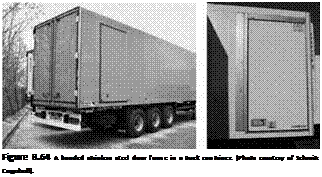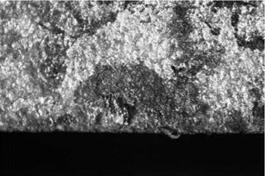Special types of steel are useful as structural materials for virtually all industrial production sectors owing to their particular material characteristics, especially their anti-corrosion properties. Historically, stainless steel has been used in the chemical and food industry, but it is also becoming popular in the building industry because their surfaces are metallically clean and visually flawless, without further surface preparation. Today, it is not only the good resistance but also the mechanical characteristics of stainless steels that are increasingly appreciated. For example, in the automobile industry, special types of steel are used for highly stressed parts to increase the rigidity and crash resistance of cars (Figure 8.64).
 |
To take full advantage of the characteristics of special steels in an overall structure, a joining technique is required that does not impair their good anti-corrosion properties and mechanical characteristics. Generally speaking, material joining techniques are preferred to mechanical ones. Welding is possible, but this entails the risk of coarse grain formation (leading to material embrittlement) and sensitization by precipitation of chromium carbides along the grain boundaries of the structure. Furthermore, with spot/tack welding and step-by-step welding, fissures are induced
|
Figure 8.65 Corrosion induced by chloride ions in a bonded joint of stainless steel (1.4376 after 5 months VDA test. Adhesive: hot curing, one-part epoxy). |
that are not allowed in food-related equipment for reasons of hygiene [50]. Strength tests performed on bonded stainless steel have shown that the quality obtained with structurally bonded stainless steel is comparable to that obtained with bonded body steel [51]. The crash-optimized, one-part epoxy resin adhesives tested have a high contamination tolerance, for example towards common auxiliary material used for forming purposes, so that costly surface preparation can be dispensed with.
It must also be considered that, with stainless steel joints, the service life expectation under climatic exposure is determined by other failure mechanisms than with the metal adherents (see also Section 7.5.1). When exposed to a warm humid environment for a prolonged time, the strength of bondings of adhesives with low resistance to corrosion was impaired by bond-line corrosion which started at the cut edges, whereas the strength of bonded Nirosta® 4301 (X5CrNi18-10) and Nirosta® H400 (X5CrMnNi19-7-3) was impaired by damages at the interface between the polymer and the metal.
Furthermore, it should be noted that, under the influence of media containing chlorides, electrochemical concentration elements are sometimes formed that may impair the anti-corrosion properties in the area of bonding (Figure 8.65). In this case, the use of stainless steels with a higher resistance to corrosion may be the solution, or perhaps passivation such as etching or electropolishing.
 1 января, 2016
1 января, 2016  Pokraskin
Pokraskin 
 Опубликовано в рубрике
Опубликовано в рубрике 